Xiangshan Park, also known as Fragrant Hills Park (香山公园), located in the northwest suburbs of Beijing, spans an area of 188 hectares and is a royal garden characterized by its mountainous forest scenery. The park’s main peak, Xianglu Peak, commonly known as “Ghost’s Fright,” rises to an elevation of 575 meters. Historically, during the Yuan, Ming, and Qing dynasties, the royalty built summer palaces and hunting lodges in Fragrant Hills. The emperors frequently visited during the summer and autumn for hunting and leisure. However, the park faced destruction twice: first by the Anglo-French Allied Forces in 1860 and later by the Eight-Nation Alliance in 1900. In 1956, it was established as a public park.
Fragrant Hills Park is home to several renowned attractions, including Xiangshan Temple, Hongguang Temple, and the Shuangqing Villa. The name “Fragrant Hills” has two historical explanations. According to folklore, the park was once filled with apricot blossoms that emitted a rich fragrance each spring, leading to its name. The second explanation comes from the “Record of Fragrant Hills Yong’an Temple,” which mentions a large stone in the shape of an incense burner, giving the hill its name.
The park is particularly famous for its vibrant autumn foliage, attracting numerous visitors who come to witness the spectacular red leaves. The natural beauty, combined with its historical sites, makes Fragrant Hills Park a unique blend of cultural heritage and natural splendor.
Table of Contents
- Basic Information
- Location and Transportation
- History of Xiangshan Park
- Highlights of Xiangshan Park
- Map and Recommended Routes
- Vlog about Xiangshan park
- Best Time to Visit Xiangshan Park
- Popular Restaurants near Xiangshan Park
- Useful Tips Summarized from Reviews
- Explore Beijing Like A Local
Basic Information
| Website | http://www.xiangshanpark.com/en/ |
| Estimated Length of Tour | Over 3 hours |
| Opening Hours | 6.00 – 19.30; Last admission: 18.30 (1st April – 15th November) 6.00 – 19.00; Last admission: 18.00 (16th November – 31st March the next year) |
| Ticket Price | 10 RMB (1st April – 15th November) 5 RMB (16th November – 31st March the next year) Biyun Temple: 10 RMB Adolescent between 6 and 18 years old enjoy a half-price discount Seniors over 60 years old and children under 6 years old or 1.2 meters are free of charge |
Location and Transportation
Xiangshan Park is located in the Haidian District of Beijing, China, about 20 kilometers northwest of the city center. The park is nestled in the foothills of the Western Hills, which form part of the Taihang Mountains. This mountainous region is characterized by its scenic beauty and is home to several other notable tourist attractions, including the Summer Palace and the Botanical Garden of Beijing. The park is easily accessible by public transportation, with several bus routes and a subway line serving the area.
Bus: Take bus 318, 360, 505, 563, 698, or 932, get off at Xiangshan Stop, and walk about 300 meters to the southwest to reach the east gate of the park, or walk about 1.2 kilometers to the northwest to reach the ticket office.
Subway: Take the Western Suburbs Subway Line, get off at Xiangshan Station, and walk about 400 meters to the southwest to reach the east gate of the park.
History of Xiangshan Park
The history of Xiangshan Park dates back more than 800 years. In the Jin Dynasty (1115-1234), the park’s location was used as a temple. During the Yuan Dynasty (1271-1368), a prince built a palace there for his mother, and the site became known as “the Fragrant Hills” due to the abundance of fragrant plants and flowers in the area.
In the Ming Dynasty (1368-1644), the emperor built a palace on the site and expanded the park. The park was further developed during the Qing Dynasty (1644-1912), with many additional structures added, including pavilions, temples, and gardens.
In the 19th century, the park fell into disrepair, but it was later restored during the Republican period (1912-1949) and was opened to the public in 1956, after the founding of the People’s Republic of China.
During the Cultural Revolution (1966-1976), many of the park’s historical buildings were damaged or destroyed. However, the park was later restored, and many of the original structures were reconstructed.
Highlights of Xiangshan Park
Xianglu Peak

Xianglu Peak, the highest point in Fragrant Hills Park, rises to an elevation of 575 meters. Its steep terrain makes it a challenging climb, earning it the nickname “Ghost Fear.” Over the years, three distinct pavilions have been constructed at its summit, each offering unique views and experiences. The Chongyang Pavilion symbolizes the tradition of ascending to high places on the Double Ninth Festival, providing a vantage point from which visitors can see the distant city of Beijing. The Tayun Pavilion, named for the clouds that often envelop it in spring and autumn, gives the sensation of walking through clouds. The Ziyan Pavilion is named for the purplish mist that appears at dawn and dusk, reminiscent of the poetic “purple mist from the incense burner.”
Yuhua Xiu
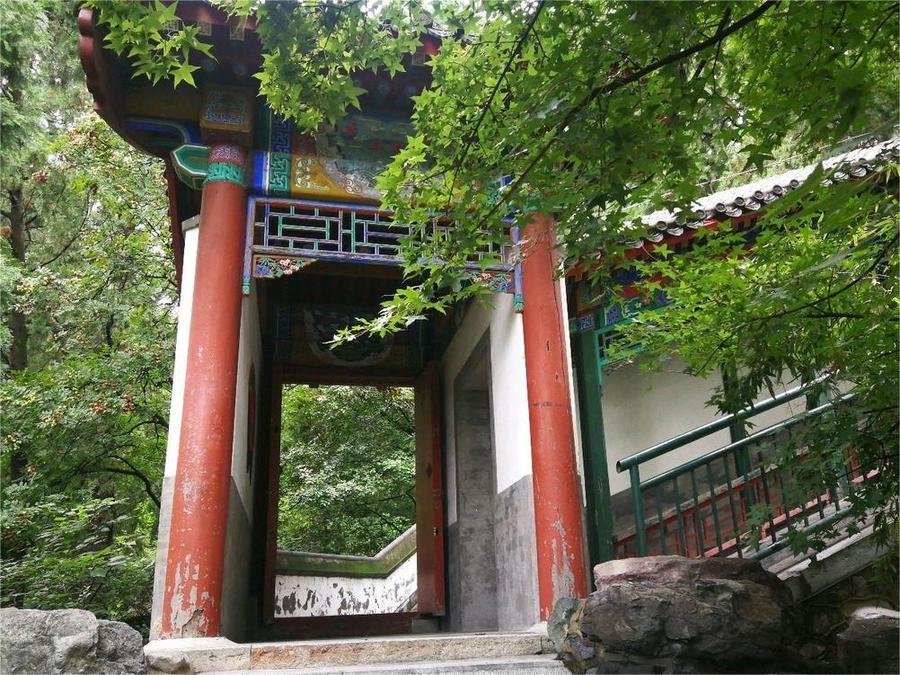
Yuhua Xiu is situated on the middle slopes of Fragrant Hills and is one of the twenty-eight scenic spots of Jingyi Garden. Originally constructed in 1745 during the reign of the Qianlong Emperor, it was destroyed by the Anglo-French forces in 1860. In 1999, the park undertook a meticulous restoration of Yuhua Xiu, reconstructing it according to historical records and its original design. The restored site is now open to the public, offering a glimpse into the elegance and tranquility of Qing Dynasty garden architecture.
Hongguang Temple

Hongguang Temple was initially established in 1468 by eunuch Zheng Tong during the Chenghua Emperor’s reign in the Ming Dynasty. Zheng Tong, originally from Korea, served the Xuanzong Emperor and later built the temple to enshrine a thousand Buddhas, inspired by his vision of the thousand Buddhas surrounding Vairochana in Mount Kumgang. In 1747, during the Qianlong Emperor’s reign, the temple’s Xiangyan Chamber was incorporated into the twenty-eight scenic spots of Jingyi Garden, with a plaque inscribed “Xiangyan Pure Land” adorning its main hall. Although the temple structures were rebuilt in the early 20th century and are not currently open to the public, the temple remains an important cultural and historical landmark within the park.
Xiangshan Temple

Xiangshan Temple, situated above Shuangqing Villa, was originally established in the 26th year of the Jin Dynasty (1186 AD). Known as Yong’an Temple, it was also referred to as Ganlu Temple. During the Yuan, Ming, and Qing dynasties, it was expanded and renovated multiple times, becoming one of the largest and most historically significant temples in the Western Hills area. Despite its cultural and artistic significance, the temple suffered extensive damage and looting during the invasions by the Anglo-French forces and the Eight-Nation Alliance. Today, only the stone screen, stone pillars, stone steps, and stone bases in front of the main hall remain. However, the temple’s sacred tree inscription, the listening pine, and the Zhile Hao in front of the temple have been well-preserved. The stone screen is intricately carved: the east side features the Diamond Sutra in the center, the Heart Sutra on the left, and the Guanyin Sutra on the right. The west side includes inscriptions of the ancient Buddha of the burning lamp, Guanyin, and Samantabhadra, along with imperial praises by the Qianlong Emperor.
Shuangqing Villa

Shuangqing Villa is located halfway up the southern slope of Fragrant Hills. The name “Shuangqing,” meaning “Double Clear,” was given by the Qianlong Emperor, inspired by the two clear springs in the courtyard. In 1920, educator Xiong Xiling established the Ciyouyuan (Charity Kindergarten) in Xiangshan, converting this area into his private residence and renaming it Shuangqing Villa. The exhibition at Shuangqing Villa is divided into two main sections: “Mao Zedong at Shuangqing” and “Mao Zedong’s Activities at Shuangqing.” The first section is a display of artifacts, recreating the environment where Mao Zedong lived and worked during his time at the villa. The second section consists of a photo and text exhibition, detailing Mao’s journey from Xibaipo to Xiangshan, his activities at Shuangqing, and his leadership during his time at Xiangshan.
Fragrant Hills Hotel

The original site of the Fragrant Hills Hotel was the Xulangzhai (Palace of Seclusion) in the Qing Dynasty’s Jingyi Garden, which served as the Qianlong Emperor’s temporary palace. In April 1957, the Beijing Municipal Bureau of Parks and the Municipal Hotel Joint Office began preparations to renovate the buildings and construct additional facilities. The hotel opened on July 16, 1957, and operated until it closed in 1976. In April 1980, the Fragrant Hills Hotel, designed by world-renowned architect I.M. Pei, began construction with an investment of 58 million yuan from the Beijing First Service Bureau. The hotel, covering over 31,000 square meters with a construction area of 38,000 square meters, officially opened on April 1, 1983. The Fragrant Hills Hotel is a prime example of modern architecture seamlessly blending with historical elements, offering visitors a luxurious stay amidst the serene beauty of Xiangshan Park.
Cuiwei Pavilion

Cuiwei Pavilion, situated on the southern side of Jingcui Lake, is one of the twenty-eight scenic spots of the Jingyi Garden. It was built in the tenth year of Emperor Qianlong’s reign (1745). The name “Cuiwei” comes from its picturesque setting among ancient trees, verdant groves, gullies, and rocky formations. It is also adjacent to other notable sites like Laiqing Pavilion, Toad Peak, and Qingyin Pavilion. This area is renowned for its lush greenery and the harmonious sounds of birds, which led Emperor Qianlong to describe the scene as “a thousand chapters of green shade in summer, with bird sounds above and below.”
East Gate

The East Gate is the main entrance of Xiangshan Park. It faces east, with bronze lions flanking either side. The large plaque with the gold-inscribed characters “Jingyi Garden,” penned by Emperor Qianlong, hangs prominently above the gate. Historically, the East Gate was flanked by two watchtowers. The southern watchtower was inscribed with “Pine Door,” and the northern with “Ivy Tent.” Inside the gate, there were also two archways. The eastern archway bore the inscriptions “Zhichan” and “Yanhe,” while the western one read “Yunqu” and “Lanban.” Beyond these archways was a stone bridge spanning a crescent-shaped river. Although the archways and watchtowers are no longer present, traces of the stone bridge and river can still be found outside the East Gate.
Qinzheng Hall
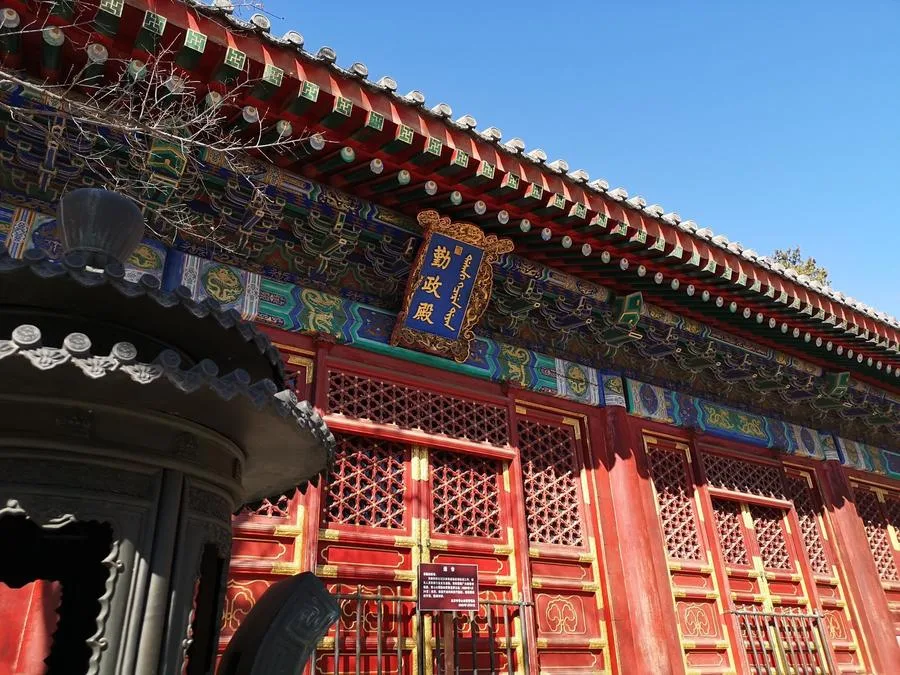
Qinzheng Hall is located just inside the East Gate of the park. It was constructed in the tenth year of Emperor Qianlong’s reign (1745) and served as the venue where the emperor handled state affairs and received officials while staying at the Jingyi Garden. As the foremost of the twenty-eight scenic spots in Jingyi Garden, Qinzheng Hall was unfortunately destroyed by the Anglo-French Allied Forces in the tenth year of the Xianfeng reign (1860), leaving only the hall’s foundation. In 2002, the park undertook a restoration project on the original site, completing the reconstruction in July 2003. The hall now stands as a prominent symbol of the imperial character of Xiangshan Park, with an exterior plaque inscribed by Emperor Qianlong himself.
Zhiyuan Hall
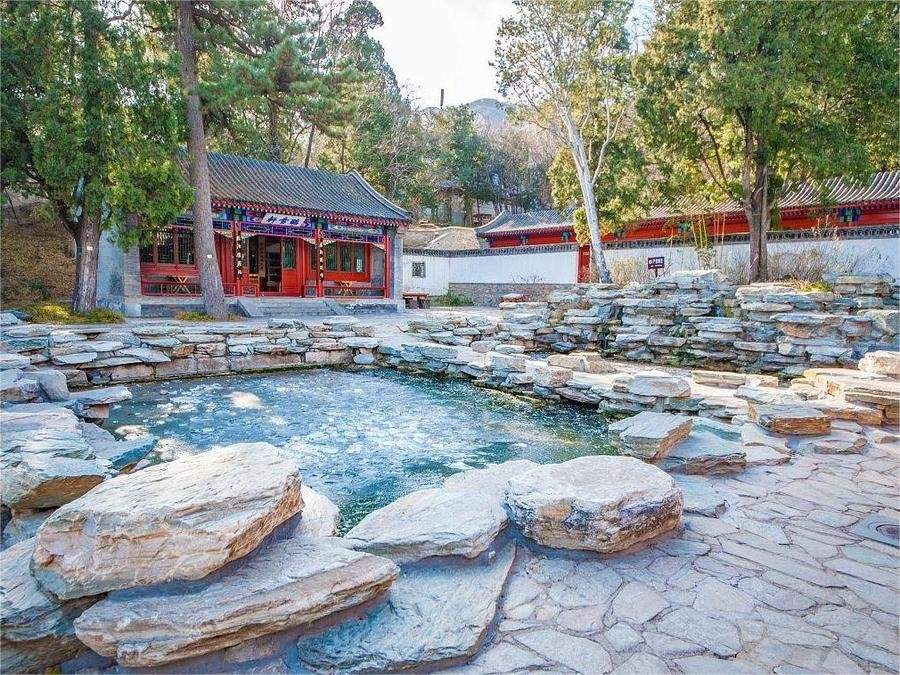
Zhiyuan Hall, built in the thirteenth year of Emperor Qianlong’s reign (1748), is part of the imperial palace complex within the Jingyi Garden, along with Qinzheng Hall, Xulang Hall, and Lizhu Tower. Covering an area of 3,430 square meters with a building area of 723 square meters, Zhiyuan Zhai is comprised of several structures, including Yunqin Zhai and Tingxue Xuan. The name “Zhiyuan” is derived from the saying, “Without simplicity, one cannot clarify one’s aspirations; without tranquility, one cannot achieve far-reaching goals,” reflecting its importance as a place where Emperor Qianlong conducted state affairs. This area was crucial for the emperor’s governance and reflects the tranquility and simplicity essential to effective leadership.
Zhisong Garden
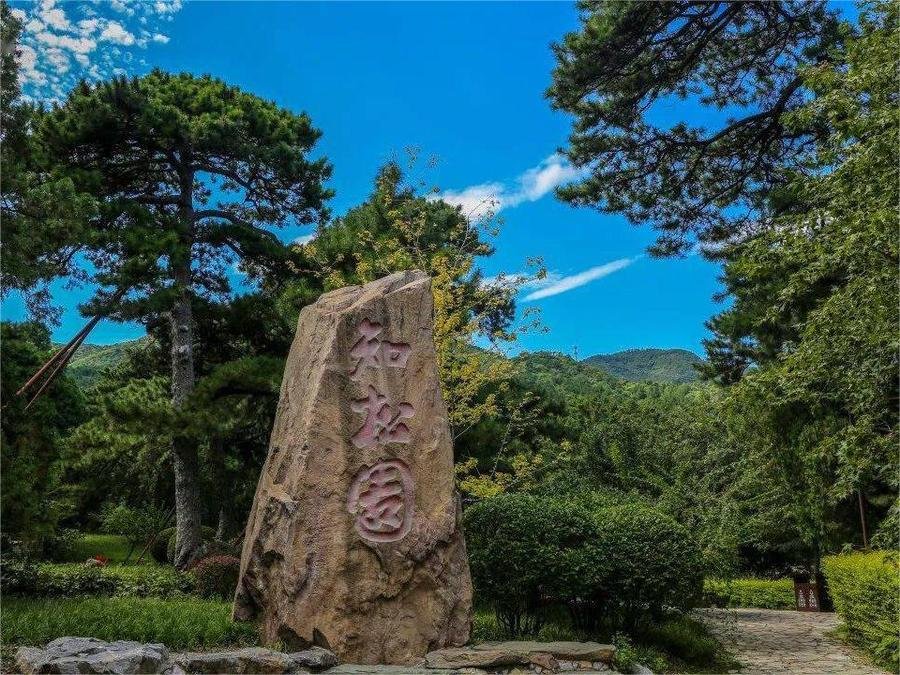
Zhisong Garden is located on the west side of the main north-south sightseeing path, occupying an area of 2 hectares. Established in 1987, the garden features over 100 ancient pines and cypress trees. A significant landmark in the garden is a massive rock measuring 1.5 meters wide, 2.5 meters long, and 5.5 meters high, inscribed with the characters “Zhisong Garden” on its front. On the back, there is a poem by Marshal Chen Yi: “The pine stands tall and straight under the heavy snow; to know its lofty character, wait until the snow melts.” The name Zhisong is inspired by a passage from the Analects of Confucius: “Only in the cold of winter do we realize that the pine and cypress are the last to wither.” This garden exemplifies resilience and strength, symbolized by the steadfastness of the pines.
Zhao Temple
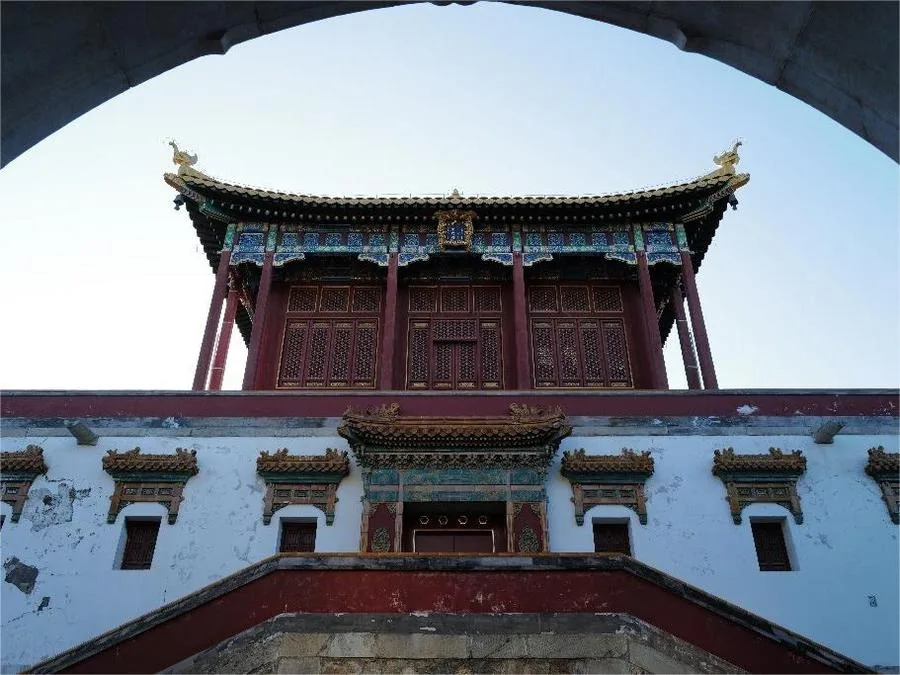
Zhao Temple, one of the significant sites within the Jingyi Garden, is formally known as the Zongjing Dazhao Temple. Construction began in the forty-fifth year of Emperor Qianlong’s reign (1780) to welcome the Sixth Panchen Lama, who came to Beijing to celebrate the emperor’s seventieth birthday. The temple, also known as the Panchen Palace, is a large Lamaist temple that combines Tibetan and Han architectural styles. It was modeled after the Tashilhunpo Monastery in Shigatse, where the Panchen Lama resided. Over the years, the temple suffered destruction by both the Anglo-French Allied Forces and the Eight-Nation Alliance. However, restoration efforts were completed in September 2012, and parts of the temple, including the forecourt and white platform, were reopened to the public. The temple’s architecture and history highlight the cultural and religious exchanges between Tibet and the Qing court.
Glazed Pagoda

The Glazed Pagoda, part of the Zongjing Dazhao Temple complex, is situated on the western slope of Xiangshan Park. Constructed in 1780 during the forty-fifth year of Emperor Qianlong’s reign, this striking structure stands approximately 30 meters tall. It features a seven-tiered, eight-sided, dense-eaves design topped with a yellow glazed vase and adorned with eight roof ridges. The base of the pagoda is supported by an umbrella-shaped structure, with white marble balustrades encircling it. The lowest level is a stone-built octagonal foundation. The edges of each tier are decorated with copper bells, which add a melodic chime to the pagoda.
Jianxin Hall

Jianxin Hall is located to the west of the park’s north gate and is one of the best-preserved ancient sites within Xiangshan Park. Originally built in 1522 during the first year of the Jiajing Emperor’s reign in the Ming Dynasty, it was reconstructed in 1796 during the first year of the Jiaqing Emperor’s reign in the Qing Dynasty. Legend has it that this area was used by emperors to test the loyalty of their ministers, hence the name “Jianxin Zhai,” meaning “Studio of Heart Testing.” The courtyard features a semi-circular pool surrounded by a painted corridor. The main hall, Jianxin Hall, faces the Zhiyu Pavilion, with Zhengning Hall situated behind it.
Eyeglasses Lake

Eyeglasses Lake, constructed during the Republic of China period, consists of two interconnected water pools resembling a pair of eyeglasses, thus its name. The northern side of the lake features rock formations and a stone cave, creating a picturesque Water Curtain Cave scene fed by the Zhuoxi stream. To the southeast of the lake stands the “Jia Ri Pavilion,” built in 1992, characterized by its cross-shaped double-eaved roof and decorated with Su-style colorful paintings.
Biyun Temple
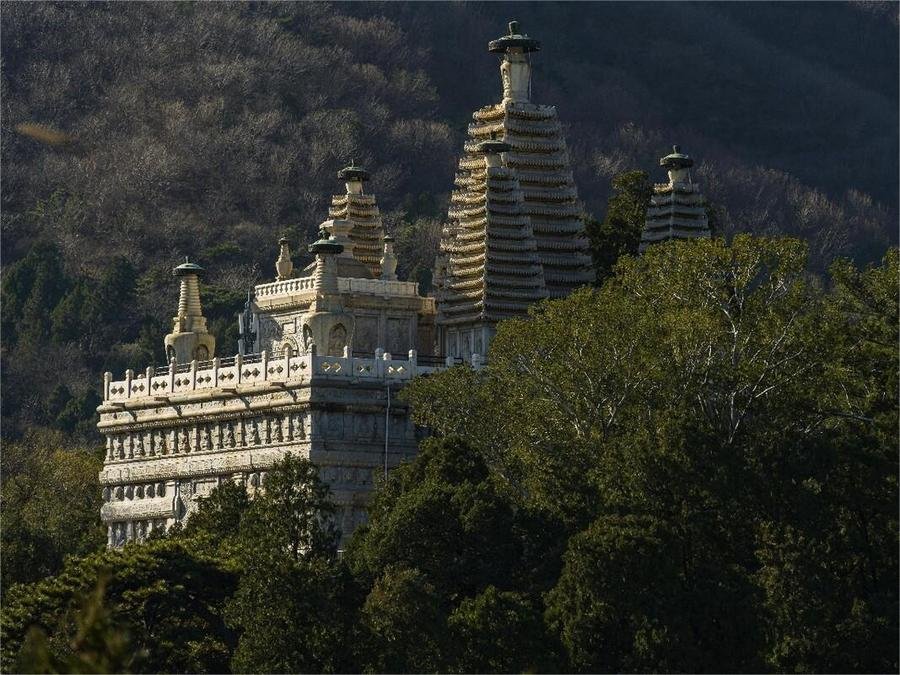
Biyun Temple, originally named Biyun An, was established in 1331 during the Yuan Dynasty. Located in the northern part of Xiangshan Park, the temple complex is built along the mountainside and faces east. The entire layout centers around six main courtyards aligned along a central axis, with additional courtyards to the north and south, covering over 40,000 square meters.
- First Courtyard: The Shanmen Hall, housing two guardian warrior statues known as Heng Ha Er Jiang, which are deities protecting the temple entrance. The bell tower and drum tower flank the sides of the courtyard.
- Second Courtyard: The Maitreya Hall, which contains a bronze Maitreya Buddha statue from the Ming Dynasty.
- Third Courtyard: The Mahavira Hall, the main hall of Biyun Temple, featuring statues that depict scenes from the teachings of Shakyamuni Buddha.
Sun Yat-sen Memorial Hall

The Sun Yat-sen Memorial Hall, situated within the grounds of Biyun Temple, has been a prominent attraction since it opened to the public on October 1, 1977. This hall is an important site for revolutionary tradition education and patriotism. At the center of the hall stands a full-body white marble statue of Sun Yat-sen, donated by the Central Committee of the Kuomintang and various Sun Yat-sen schools across China. The walls feature inscriptions of Sun Yat-sen’s writings, including his “Letter to the Soviet Union,” carved in white marble. In the northwest corner of the main hall, there is a glass-covered steel coffin sent by the Soviet people on March 30, 1925. The memorial hall also displays Sun Yat-sen’s calligraphy and works, offering a deep insight into his legacy and contributions to China’s revolutionary history.
Mountain Flower Exhibition

Since 2003, Xiangshan Park has hosted an annual Mountain Flower Exhibition, also known as the Mountain Flower Appreciation Festival, from April to May. The first exhibition predominantly featured Ranunculus flowers, along with small chrysanthemums and other flowering plants, totaling 70,000 pots and over 20 different species. The park sets up 75 educational display boards in major scenic areas to promote botanical knowledge. Additionally, the exhibition includes a mascot named “Tao Tao,” symbolized through a simplified sculpture, which adds a playful and engaging element to the festival.
Red Leaf Cultural Festival
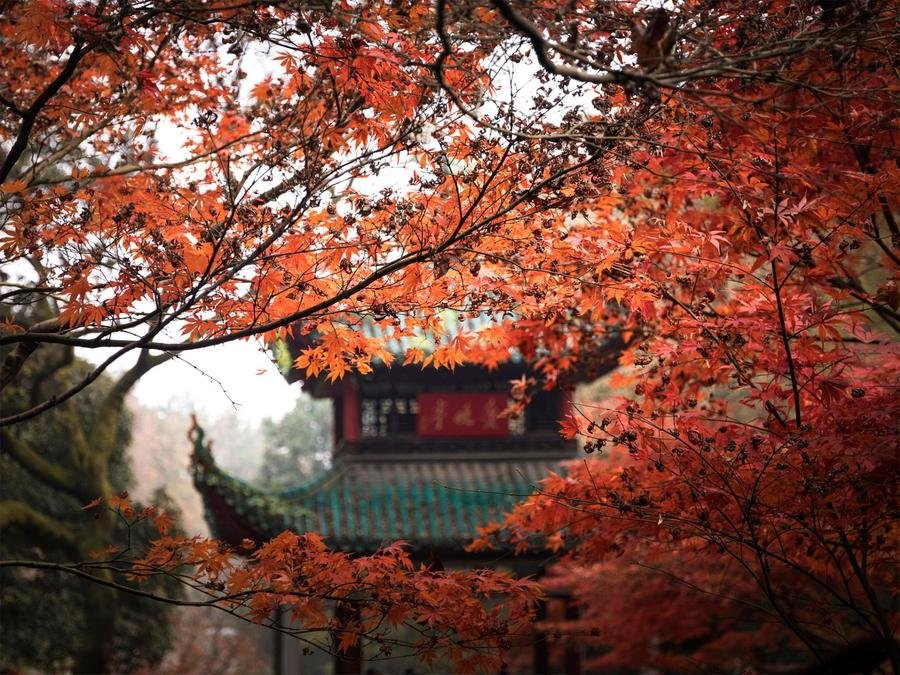
The Red Leaf Cultural Festival, held annually since 1989, is a major attraction in Xiangshan Park, celebrating the vibrant autumn foliage. The festival features various types of red-leaf trees, including Acer pentaphyllum, Acer buergerianum, Acer palmatum, and Diospyros kaki. The most abundant red-leaf species is the Cotinus coggygria, with nearly 100,000 trees throughout the park. These trees are rich in chlorophyll, xanthophyll, carotene, and anthocyanin. During spring and summer, chlorophyll dominates, making the leaves appear green. In autumn, as temperatures drop and the day-night temperature variation increases, chlorophyll synthesis is inhibited and breaks down, while carotene and anthocyanin increase, turning the leaves into vibrant shades of red, yellow, and orange. This natural process creates a stunning, colorful landscape that attracts countless visitors each year.
Map and Recommended Routes

North Route: For Adventurous Visitors
The North Route is ideal for those who are physically fit and looking for a more challenging hike with a variety of attractions. The journey starts at the East Gate and covers a lot of ground with several scenic spots.
Begin your adventure at the East Gate and head towards Qinzheng Hall, where you can appreciate the historical architecture. From there, make your way to Zhiyuan Zhai, a serene spot ideal for reflection. Continue to Zhenfang Building and Zhen Nan Room, exploring these historic structures before heading to Zhiyuan Garden.
Next, walk to Wensong Pavilion, a peaceful area surrounded by lush greenery. Proceed to Zhaomiao Temple, an important cultural site, and then to Eyeglasses Lake, known for its picturesque setting. Continue your hike to Jianxin Zhai, a place with historical significance, and then visit Geyun Bell. From there, head to Furong Ping, a beautiful open space perfect for taking in the views.
As you advance, you will reach Yanfei Weixiu and then move on to Chongcui Qi, known for its stunning natural scenery. The journey continues to Ti Yun Mountain Pavilion and Xiangwu Cave, where you can enjoy tranquil moments. Finally, climb up to Xishan Qingsnow for a panoramic view of the park and finish your hike at Xianglu Peak, the highest point of the park offering magnificent views.
Central Route: For Photographers
The Central Route is perfect for those who enjoy photography and prefer a more leisurely walk. Start at the East Gate and make your way to Qinzheng Hall, the first of many beautiful sites on this route. From Qinzheng Hall, head to Zhiyuan Zhai, a scenic area with great photo opportunities.
Continue from Zhiyuan Zhai to Lizhuluo, a spot known for its charming views, and then proceed to Xiaobai Lou. Next, visit Zhijia Pavilion and Yuru Spring, which offer picturesque landscapes. From Yuru Spring, head to Yuhua Temple, another visually appealing site.
Your walk continues to Yanfei Weixiu and then to Duojing Pavilion, a lovely place for photography. Move on to Qiyue Mountain Villa and enjoy the views from the Yuncao Pavilion. Finally, visit Xiangwu Cave and climb to Xianglu Peak for breathtaking photographs of the park and its surroundings.
South Route: For Casual Visitors
The South Route is suited for those with average fitness levels looking for a relaxing visit. Begin at the East Gate and make your way to Qinzheng Hall, a historical starting point for your journey. From there, head to Jingcui Lake, a calm and scenic spot perfect for a leisurely walk.
Continue from Jingcui Lake to Cuiwei Pavilion, where you can enjoy tranquil views. Then visit Yingluo Rock and Shuangqing Villa, two serene and picturesque spots. Move on to Laiqing Pavilion and then to Xiangshan Temple, a significant cultural site in the park.
From Xiangshan Temple, proceed to Baishong Pavilion and Xuankou Forest, which offer serene natural environments. Finish your journey at Lanfeng Pavilion and climb up to Xianglu Peak for a satisfying conclusion to your visit.
Cable Car Route: For a Quick and Easy Visit
If you prefer a more relaxed visit with less physical exertion, the Cable Car Route is an excellent option. Start at the East Gate and take the cable car to Xianglu Peak for a quick and easy way to reach the summit.
Vlog about Xiangshan park
Best Time to Visit Xiangshan Park
Spring (March to May)
Characteristics: Spring is a wonderful time to visit Xiangshan Park as the weather warms up and the landscape transforms into a vibrant display of greenery and blooming flowers. The park’s trees and grasslands come to life, creating a beautiful and refreshing environment.
Flower Viewing: Spring is the prime season for flower enthusiasts. The park hosts various flower exhibitions, such as the “Spring at Xiangshan” event. During this period, you can see a range of spring flowers including buttercups, horned violets, and large-flowered larkspurs. The best spots for flower viewing are Jia Ri Garden, Maple Forest Village, and the area around the cable car station. These locations offer stunning floral displays and picturesque settings for leisurely walks and photography.
Summer (June to August)
Characteristics: Summer at Xiangshan Park can be hot, but the park’s environment offers a cooler retreat from the city’s heat. The lush greenery and the presence of water features like the Rose Garden and Lotus Pond provide refreshing spots to escape the summer sun.
Activities: During summer, explore the park in the early morning or late afternoon to avoid the peak heat of the day. Engage in summer activities such as attending evening concerts or cultural performances often held in the park. The cooler temperatures in the morning and evening make these times ideal for a leisurely stroll or a more intense hike.
Autumn (September to November)
Characteristics: Autumn is arguably the most enchanting season at Xiangshan Park. The weather is pleasantly cool, and the park is renowned for its stunning fall foliage. From mid-October to early November, the park’s trees turn vibrant shades of red, orange, and yellow, offering breathtaking views.
Red Leaf Viewing: This is the best time for leaf-peeping. The peak period for autumn foliage lasts about a month, making it perfect for exploring the park’s famous spots like Xianglu Peak, Yuhua Summit, and Senyu Hut. Whether you’re hiking up the trails or taking the cable car, the colorful scenery is sure to impress.
Winter (December to February)
Characteristics: Winter brings a different kind of beauty to Xiangshan Park with its snow-covered landscapes and tranquil atmosphere. The park is relatively quiet during this season, offering a serene retreat from the busyness of the city.
Activities: Winter is a great time to try winter sports at the nearby Xiangshan Ski Resort. You can also enjoy a peaceful walk through the snow-covered trails and take in the crisp winter air. On clear winter days, the park’s scenery under the sunlight is quite picturesque.
Popular Restaurants near Xiangshan Park
| Restaurant | Location | Average Cost | Description | Recommended Dishes |
|---|---|---|---|---|
| Songlin Restaurant (香山公园松林餐厅) | Near the North Gate of Xiangshan Park (Inside the Park) | ¥70 | Located within the park with outdoor seating. A comfortable spot for dining after a park visit. | Stir-Fried Pancakes (素炒饼), Kung Pao Chicken (宫保鸡丁) |
| Lanxi Small Restaurant (兰溪小馆) | Near the North Gate of Xiangshan Park (Outside the Park) | ¥100 | Just outside the park. Offers a pleasant environment and Southern-style dishes with lighter flavors. | Scallion Oil Noodles (葱油拌面), Braised Bamboo Shoots (油焖笋) |
| That Small Restaurant (那家小馆) | East Gate of Xiangshan Park, at the street corner | ¥110 | Known for the best service among local restaurants, featuring Beijing-style dishes with a cozy atmosphere. | Spring Pancake Rolls (春饼合菜), Peking Duck (烤鸭) |
| Wofoshan Vegetarian Restaurant (卧佛山庄素菜馆) | Near the National Botanical Garden Wofosi (Inside the Park) | ¥120 | A bit pricey, but conveniently located within the park. Known for its vegetarian dishes. | Lion’s Head Meatballs (狮子头) |
| Xiaodiao Pear Soup (小吊梨汤) | Near the West Gate of the South Garden of the National Botanical Garden | ¥75 | Features a nice environment with private rooms and good service. Specializes in traditional Beijing dishes. | Crispy Boneless Chicken (酥香脱骨鸡), Dry-Braised Yellow Fish (干烧黄鱼), Fried Bean Paste Noodles (炸酱面) |
| Seasonal Living (节气生活) | Opposite the Science Education Center, North District of the National Botanical Garden | ¥35 | A dessert shop with a great ambiance, ideal for tea and light snacks. Good for relaxing and photo opportunities. | Fruit Tea (花果茶), Pastries (糕点) |
| Grassland Fragrant Hot Pot (草原香涮肉) | Next to Xiangshan Metro Station | ¥90 | A great hot pot restaurant near the metro station, perfect for a meal before or after a park visit. | Lamb Offal Soup (羊杂汤), Sesame Cakes (烧饼) |
Useful Tips Summarized from Reviews
Best Time to Visit for Red Leaves: Late October to early November is the best time to enjoy the vibrant red leaves. Missing this window means waiting for another year. However, be prepared for large crowds on weekends, so it’s advisable to avoid visiting during this time.
Storage Facilities: There are no free storage facilities available in the park. It’s recommended to travel light to avoid any inconvenience.
Descending from the North Slope: It’s advisable to avoid descending from the north slope of the mountain. The paths are often unpaved and steep, posing safety risks. Opt for alternative routes or use the southern slopes for a safer descent.



It was my first time visiting Xiangshan Hill, and the weather was great, with beautiful scenery, especially since there were not many people around. The mountain isn’t very high; I took the southern trail. It took me about an hour and a half to hike up and 50 minutes to come down. My knees and toes were a bit sore during the descent. From the top of the mountain, you can see a distant view of the city, and I’m… Read more »
Last week, I noticed that Xiangshan Hill was still somewhat bare, but today it looks completely revived. Everywhere is covered in lush greenery of all kinds, and I can feel the vibrant power of life all around.
The scenery at Xiangshan Hill during this season is still quite nice, with fewer people around and pleasant views. If you take the suburban train, you might even find a seat. Many spring flowers are in bloom at Xiangshan; although it can’t be described as a sea of flowers, you can certainly see a lovely display of mountain blossoms. If you’re in good shape, I recommend hiking to the summit, as the view from the top is truly beautiful and… Read more »
This year, the plum blossoms at Xiangshan Park bloomed earlier than usual. The flowers are also in better condition compared to last year. Currently, around 80% of the plum blossoms in the valley are in bloom. As in previous years, there aren’t many people around.
Indeed, there aren’t many people at Xiangshan Hill in winter. From the summit, you can overlook the city of Beijing.